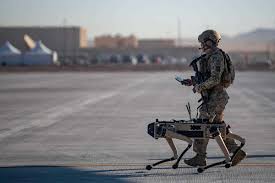
Military and Defense Robotics: Boon or Risk?
Military and defense robotics are revolutionizing warfare with their ability to enhance safety, precision, and efficiency. These technologies assist in combat support, surveillance, and logistics, reducing risks for human soldiers. However, they also raise serious concerns about ethics, accountability, cybersecurity, and the potential misuse of autonomous weapons. As nations continue to invest in robotic defense systems, the challenge lies in maintaining global security while regulating their us
✨ Raghav Jain

Introduction
Modern warfare has undergone a seismic shift with the integration of advanced technologies, and robotics is at the forefront of this transformation. What once seemed like the realm of science fiction—robots on the battlefield—has now become reality. From unmanned drones to autonomous ground vehicles, military and defense robotics are changing the way wars are fought, strategies are planned, and missions are executed.
But this evolution brings with it a critical question: Are these machines a boon to global security, or do they pose a serious risk to humanity and ethical warfare? On one hand, robotics in defense can save human lives, increase precision, and offer strategic advantages. On the other, they raise concerns about accountability, escalation of conflict, and the moral dilemmas of autonomous lethal systems.
This article delves deep into the benefits, risks, ethical debates, real-world examples, and future outlook of robotics in military and defense, helping us understand whether this innovation is a safeguard—or a sword. The integration of robotics into military and defense operations represents a paradigm shift in the landscape of warfare, offering a complex tapestry of potential benefits and significant risks that demand careful consideration. Proponents argue that military robotics presents a unique opportunity to enhance operational effectiveness, reduce human casualties, and execute tasks in environments deemed too dangerous or physically demanding for soldiers. Robots excel in the "three Ds" – dull, dirty, and dangerous tasks – such as reconnaissance in hostile territories, the detection and disposal of explosive ordnance, and logistical support in contested zones. Unmanned aerial vehicles (UAVs), commonly known as drones, have become ubiquitous in modern conflicts, providing persistent surveillance capabilities, conducting targeted strikes with increasing precision, and minimizing the risk to aircrews. Unmanned ground vehicles (UGVs) can navigate complex terrains, conduct reconnaissance missions, and even be equipped with weaponry, offering a versatile platform for various ground-based operations. Furthermore, robotic systems can operate continuously for extended periods, unburdened by human limitations such as fatigue or emotional stress, potentially leading to more consistent and reliable performance in critical situations. The integration of artificial intelligence (AI) into these robotic platforms promises even greater autonomy and decision-making capabilities, allowing them to adapt to dynamic battlefield conditions and potentially react faster than human operators. This enhanced speed and precision can be crucial in neutralizing threats and achieving tactical objectives, while also potentially minimizing collateral damage and civilian casualties through more discriminate targeting. The development of robotic exoskeletons and powered armor also holds the promise of augmenting the physical capabilities of soldiers, enhancing their strength, endurance, and carrying capacity, thereby improving their survivability and effectiveness on the battlefield. From a strategic perspective, military robotics can offer a significant force multiplier, allowing smaller personnel deployments to achieve broader operational goals. They can also be more cost-effective in the long run compared to maintaining large standing armies and replacing personnel lost in combat. The ability to deploy robots in high-risk scenarios can also reduce the political and social costs associated with military interventions, as the potential for domestic casualties decreases. Moreover, the continuous advancements in robotics and AI can drive innovation in the defense industry, leading to the development of cutting-edge technologies with potential spillover benefits for civilian applications.
However, the increasing reliance on military robotics is fraught with potential risks and ethical dilemmas that cannot be ignored. One of the most pressing concerns revolves around the issue of autonomous weapons systems, often referred to as "killer robots." These systems, capable of identifying, selecting, and engaging targets without direct human intervention, raise profound ethical questions regarding accountability, the laws of war, and the potential for unintended escalation. The removal of human control from the decision-making process in lethal engagements could lead to unintended consequences, errors in target identification, and a blurring of the lines of responsibility for civilian casualties. Critics argue that delegating the power to take a human life to a machine crosses a fundamental moral threshold and could lead to a dehumanization of warfare. The potential for these autonomous systems to fall into the wrong hands or to malfunction also poses a significant security risk. Furthermore, the development and deployment of advanced military robotics could trigger a dangerous arms race, as nations compete to develop and acquire the most sophisticated systems, potentially leading to increased instability and a higher risk of conflict. The lack of human empathy and nuanced judgment in robotic systems is another critical concern. Military operations often require complex ethical considerations and the ability to make context-dependent decisions that go beyond pre-programmed algorithms. Relying solely on robotic systems could lead to a deficit in these crucial human elements, potentially resulting in unintended harm or violations of international humanitarian law. The vulnerability of robotic systems to cyberattacks and electronic warfare also presents a significant risk. Adversaries could potentially hack into these systems, taking control of them, disrupting their operations, or even turning them against their own forces. The reliance on complex software and network infrastructure also creates new vulnerabilities that need to be constantly addressed. Moreover, the increasing automation of warfare could lead to a deskilling of human soldiers in certain areas, making them overly reliant on technology and potentially less effective in situations where robotic systems are unavailable or compromised. The psychological impact on soldiers who operate lethal robots remotely, potentially distanced from the consequences of their actions, also warrants careful consideration. The potential for job displacement within the military due to the increasing use of robotics is another factor to consider, although proponents argue that robots will primarily augment human capabilities rather than replace soldiers entirely. Finally, the legal and regulatory frameworks governing the development and deployment of military robotics are still evolving, and there is a lack of international consensus on issues such as the definition of autonomous weapons, the standards of accountability, and the rules of engagement for robotic systems. Addressing these complex legal and ethical challenges is crucial to ensuring the responsible and safe integration of robotics into military and defense operations. In conclusion, while military and defense robotics offers significant potential benefits in terms of operational effectiveness and force protection, it also presents substantial risks related to ethics, security, and the potential for unintended consequences. Navigating this complex landscape requires a cautious and thoughtful approach, with a strong emphasis on human oversight, ethical considerations, and the development of robust legal and regulatory frameworks to ensure the responsible use of these transformative technologies. The future of warfare will undoubtedly be shaped by the continued advancement of robotics, but it is imperative that this evolution is guided by a clear understanding of both the boons and the risks involved to ensure a more secure and humane future.
What Are Military and Defense Robots?
Military robots are machines designed to support and enhance defense operations. These robots can be controlled remotely or operate autonomously using artificial intelligence. They come in various forms and are deployed for diverse roles, including:
- Unmanned Aerial Vehicles (UAVs): Commonly known as drones, used for surveillance, reconnaissance, and targeted strikes.
- Unmanned Ground Vehicles (UGVs): Robotic vehicles for land-based missions such as bomb disposal, logistics, and battlefield support.
- Autonomous Underwater Vehicles (AUVs): Used by naval forces for mine detection, surveillance, and underwater missions.
- Robotic Exoskeletons: Wearable suits that enhance soldier strength and endurance.
- Combat Robots: AI-enabled robots capable of offensive tasks like shooting or neutralizing enemies.
Driven by advances in AI, sensor technology, and machine learning, these robots are not only tools of modern defense but also reshape the doctrine of warfare itself.
The Benefits: Why Military Robotics Are Considered a Boon
1. Reducing Human Casualties
Perhaps the most widely recognized benefit of military robots is protecting human lives. Robots can be deployed in highly dangerous environments—such as minefields, conflict zones, or disaster areas—reducing the risk to soldiers.
For instance, explosive ordnance disposal robots have saved countless lives by handling bombs without putting human technicians in harm’s way.
2. Enhancing Precision and Efficiency
Autonomous drones equipped with AI can analyze terrain, identify targets, and carry out operations with unmatched precision. This reduces collateral damage and civilian casualties, especially in urban warfare where split-second decisions matter.
3. Surveillance and Intelligence Gathering
Military robots equipped with cameras, sensors, and thermal imaging can conduct 24/7 surveillance in terrains inaccessible to humans. They help commanders monitor enemy movements, assess risks, and plan strategies based on real-time data.
4. Force Multiplication
Robots can serve as force multipliers, enabling fewer troops to achieve more. For example, a single drone can perform the work of an entire reconnaissance unit, while a swarm of robots can overwhelm enemy defenses with speed and coordination.
5. Logistics and Support Operations
Robots are increasingly used in transporting ammunition, medical supplies, and equipment across rough terrains or active battlefields. This reduces fatigue for human soldiers and enhances operational continuity.
The Risks: What Makes Military Robotics a Global Concern?
1. Autonomous Weapons and Moral Dilemmas
One of the most controversial developments in military robotics is the autonomous weapon system (AWS)—robots that can select and engage targets without human input. While they promise speed and efficiency, they pose critical ethical challenges:
- Can a machine make life-and-death decisions?
- Who is accountable if it makes the wrong choice?
- Is it morally acceptable to delegate killing to algorithms?
Critics argue that removing human judgment from warfare decisions undermines international law and humanitarian principles.
2. Escalation of Conflict
The availability of robotic weapons may lower the threshold for war. Since robots reduce the risk of human casualties for the attacker, nations may become more willing to engage in military actions. This could lead to more frequent and rapid conflicts.
Moreover, autonomous swarms—hundreds of mini-drones operating as a single unit—pose an escalation risk by overwhelming defenses and triggering retaliations.
3. Hacking and Cybersecurity Threats
Robots connected to digital networks are vulnerable to cyberattacks. If an enemy hacks into a robotic defense system, they could:
- Take control of drones or tanks
- Steal sensitive data
- Turn weapons against their own forces
In such a scenario, the very tool designed to protect could become the instrument of disaster.
4. Loss of Human Oversight
As machines become more intelligent, there’s a growing risk of humans being removed from the loop. Military decisions may be left to AI systems trained on incomplete or biased data, increasing the risk of unintended actions.
5. Legal and Political Accountability
If a military robot mistakenly kills civilians, who should be held responsible?
- The manufacturer?
- The military commander?
- The software developer?
Current international laws and conventions are not equipped to handle these complexities, leaving a dangerous legal vacuum.
Real-World Examples of Military Robotics
1. United States: MQ-9 Reaper Drones
Used extensively in Afghanistan, Iraq, and Syria, the MQ-9 Reaper drone has been deployed for surveillance and precision strikes. Though operated remotely, its advanced targeting systems raise concerns about civilian casualties and accountability.
2. Russia: Uran-9 Combat Robot
The Uran-9 is an unmanned ground combat vehicle equipped with machine guns and anti-tank missiles. It was tested in Syria but showed limitations due to remote communication failures—a reminder that not all robotic systems are foolproof.
3. Israel: Harop "Kamikaze" Drone
The Harop drone is designed to loiter over a target area and dive onto a selected target, exploding on impact. It combines surveillance with suicide attack capabilities, raising debates about pre-programmed lethal autonomy.
4. China: Robotic Warfare Investment
China is heavily investing in AI-powered combat drones and autonomous tanks, signaling a future arms race in military robotics.
Global Policies and Ethical Debates
International organizations like the United Nations and NGOs like Human Rights Watch are actively campaigning against “killer robots”—fully autonomous weapons that could be deployed without meaningful human control.
Key points of debate include:
- Should autonomous lethal weapons be banned?
- How much human oversight is necessary?
- How do we ensure transparency and accountability?
The Campaign to Stop Killer Robots argues that allowing machines to take life undermines the fundamental principles of human rights and dignity.
Some nations support a pre-emptive ban, while others argue for developing guidelines and regulatory frameworks instead of outright prohibitions.
The Role of AI and Emerging Technologies
Modern military robots are powered by more than just mechanics—they rely on:
- Artificial Intelligence for decision-making
- Machine Learning to improve performance
- Computer Vision for object detection
- Edge Computing for faster data processing
- Swarm Technology for collaborative robot missions
These emerging technologies promise to make military robotics more efficient, autonomous, and deadly—which is both a technological triumph and a moral minefield.
Balancing Innovation with Responsibility
The future of defense robotics depends on how we balance technological progress with ethical responsibility. Governments, military leaders, scientists, and civil society must work together to:
- Create international regulations for development and use
- Promote transparency in deployment
- Ensure human oversight remains central in lethal decision-making
- Educate stakeholders about risks and boundaries
Technological advancement should serve humanity, not undermine it.
Conclusion
Military and defense robotics are undeniably transforming the nature of modern warfare. They offer undeniable benefits—fewer casualties, enhanced precision, real-time intelligence, and strategic advantages. But with these benefits come equally serious risks: ethical dilemmas, accountability issues, cyber vulnerabilities, and the potential for escalation.
In the debate between boon or risk, the answer is not black and white. It depends on how we develop, regulate, and use this technology. When guided by ethical standards, international laws, and a commitment to human rights, military robotics can be a powerful tool for national security and peacekeeping.
However, if left unchecked or used irresponsibly, they could become a ticking time bomb that destabilizes global peace.
As we stand on the threshold of a new era in warfare, the choice lies in our hands—not the machines'. Let us wield this power wisely, with foresight, caution, and humanity.
Q&A Section
Q1: What are military and defense robotics?
Ans: Military and defense robotics are automated machines and systems used in warfare or defense operations for tasks like surveillance, bomb disposal, logistics, and combat support.
Q2: How are robotics benefiting modern military operations?
Ans: Robotics enhance military efficiency by reducing human casualties, improving precision, enabling remote surveillance, and performing dangerous tasks that are risky for soldiers.
Q3: What are the ethical concerns related to autonomous military robots?
Ans: Ethical concerns include the lack of accountability in decision-making, potential civilian harm, violation of international laws, and the possibility of machines making life-and-death choices without human input.
Q4: How do robots improve battlefield strategy and decision-making?
Ans: Robots equipped with AI and real-time data capabilities help in quick threat detection, data analysis, and strategic planning, enabling faster and more accurate decisions on the battlefield.
Q5: What risks are associated with hacking and cybersecurity in defense robotics?
Ans: Hacking poses a serious risk, as compromised robots can be used against their own forces, leak classified information, or cause unintended destruction.
Q6: Can military robots replace human soldiers completely?
Ans: While robots can assist and perform many functions, they cannot fully replace human soldiers due to limitations in emotion, judgment, and adaptability in unpredictable combat scenarios.
Q7: How are countries investing in military robotics development?
Ans: Countries like the U.S., China, and Russia are heavily investing in R&D for drone systems, robotic vehicles, and AI-based weapons to gain technological superiority in defense.
Q8: What international laws govern the use of military robots?
Ans: International laws like the Geneva Conventions and discussions under the United Nations aim to regulate the development and use of lethal autonomous weapons systems (LAWS), though enforcement remains challenging.
Q9: How do military robots affect global peace and security?
Ans: While they can deter threats and reduce conflict-related casualties, unregulated use and arms races in autonomous weapons may destabilize global peace and increase the risk of war.
Q10: Is military robotics a boon or a risk for the future?
Ans: Military robotics are both a boon and a risk—boon in terms of safety, efficiency, and technological advancement; risk due to ethical dilemmas, misuse, and potential loss of human control.
Similar Articles
Find more relatable content in similar Articles

From Classroom to Career: App..
Skill-building apps help stud.. Read More

Top Educational Apps That Boos..
Educational apps are transfor.. Read More

Smart Study to Smart Career: ..
Smart study and career apps a.. Read More

The Future of Social Media Ma..
AI is transforming social med.. Read More
Explore Other Categories
Explore many different categories of articles ranging from Gadgets to Security
Smart Devices, Gear & Innovations
Discover in-depth reviews, hands-on experiences, and expert insights on the newest gadgets—from smartphones to smartwatches, headphones, wearables, and everything in between. Stay ahead with the latest in tech gear
Apps That Power Your World
Explore essential mobile and desktop applications across all platforms. From productivity boosters to creative tools, we cover updates, recommendations, and how-tos to make your digital life easier and more efficient.
Tomorrow's Technology, Today's Insights
Dive into the world of emerging technologies, AI breakthroughs, space tech, robotics, and innovations shaping the future. Stay informed on what's next in the evolution of science and technology.
Protecting You in a Digital Age
Learn how to secure your data, protect your privacy, and understand the latest in online threats. We break down complex cybersecurity topics into practical advice for everyday users and professionals alike.
© 2025 Copyrights by rTechnology. All Rights Reserved.